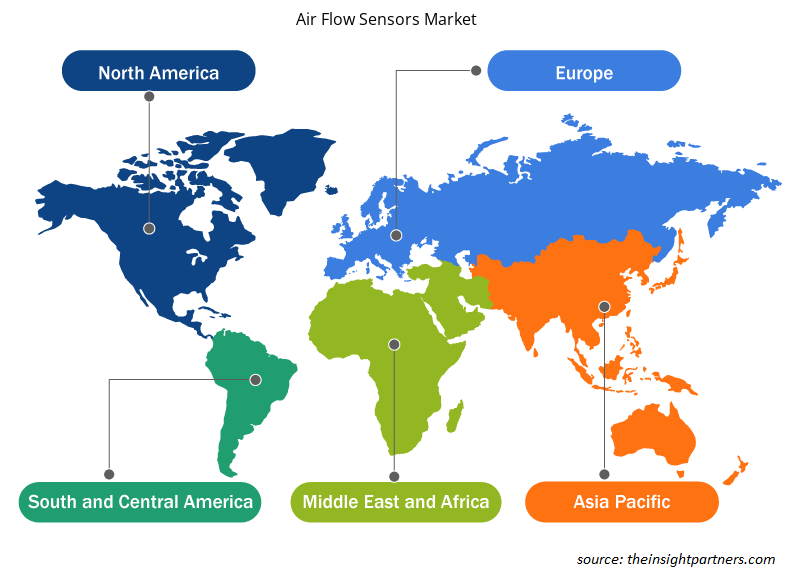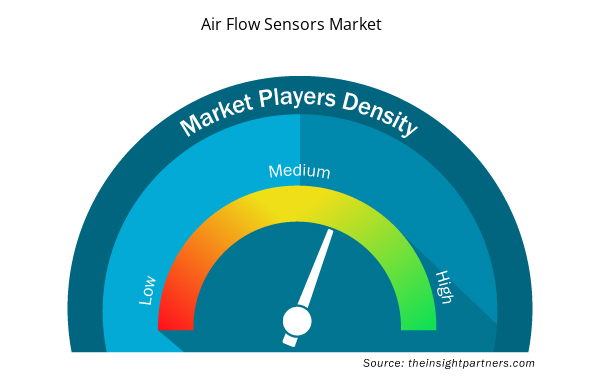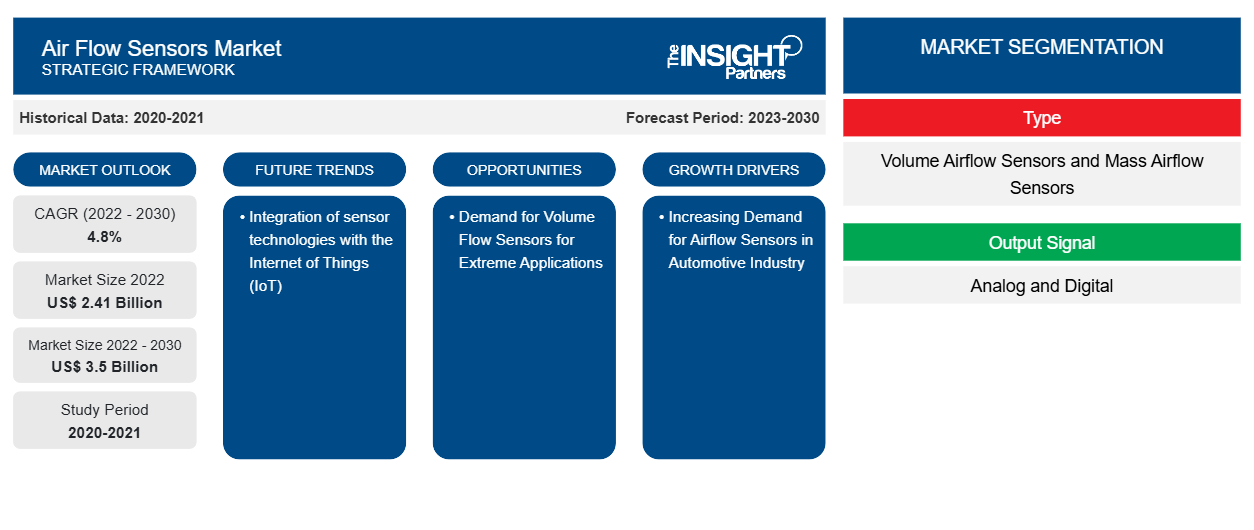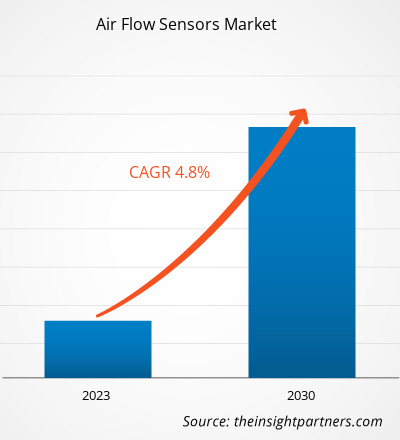预计到 2030 年,气流传感器市场规模将从 2022 年的 24.1 亿美元增至 35 亿美元。预计 2022-2030 年期间市场复合年增长率将达到4.8%。传感器技术与物联网 ( IoT ) 的融合可能仍是市场的主要趋势。
空气流量传感器市场分析
HVAC系统使用气流传感器来确保高效运行并降低能耗。HVAC系统具有气流传感器,可将该区域的实际温度与目标温度进行比较并采取适当的措施。HVAC控制经常用于各种商业领域,包括酒店、企业、零售和住宅。
空气流量传感器市场概况
气流传感器用于确定通道中空气的流量或质量。气流传感器有两种类型。它们是质量气流传感器和体积气流传感器。气流传感器易于安装,可测量整个压力、气流的静压和空气速度。气流传感器广泛应用于各种工业系统。在汽车中,气流传感器对于保持最佳燃油效率和排放水平至关重要,并帮助发动机控制单元调整燃油喷射以确保高效燃烧。
定制此报告以满足您的需求
您可以免费定制任何报告,包括本报告的部分内容、国家级分析、Excel 数据包,以及为初创企业和大学提供优惠和折扣
- 获取此报告的关键市场趋势。这个免费样品将包括数据分析,从市场趋势到估计和预测。
空气流量传感器市场驱动因素和机遇
汽车行业对气流传感器的需求增加,利好市场
汽车行业是气流传感器的主要终端用户。对汽车的需求不断增长同时也推动了对气流传感器的需求,因为这些传感器用于发动机和排气系统以监测和控制气流。汽车行业正在全球范围内迅速发展。此外,电动汽车在全球的普及率也在大幅提高。据欧盟委员会称,汽车行业为 1,380 万欧洲人提供了直接和间接的就业机会,占欧洲总就业人数的 15.1%。根据欧洲运输和环境联合会引用的统计数据,英国政府承诺到 2050 年实现净零排放目标,并提议到 2035 年禁止销售所有污染汽车。因此,净零排放计划和消费者对环保汽车的需求推动了气流传感器市场的发展。
极端应用对体积流量传感器的需求
汽车、航空航天、制造业、电力和公用事业等众多行业都对能够承受极端条件的体积流量传感器有着极高的要求。这鼓励市场参与者开发用于极端应用的体积流量传感器。例如,2023 年 9 月,ENVEA推出了AirFlow P,这是用于极端应用的高温版本的体积流量传感器。AirFlow P 是一种用于粉尘负荷传感器中的体积流量测量传感器,适用于高达 800°C 的高温应用。
空气流量传感器市场报告细分分析
有助于得出空气流量传感器市场分析的关键部分是类型和应用。
- 根据类型,气流传感器市场分为体积气流传感器和质量气流传感器。体积气流部分在 2022 年占据了较大的市场份额。
- 根据应用,市场分为汽车、航空航天、制造业、电力和公用事业等。汽车领域在 2022 年占据了更大的市场份额。
空气流量传感器市场份额(按地区)分析
空气流量传感器市场报告的地理范围主要分为五个区域:北美、亚太、欧洲、中东和非洲、南美和中美。
日本、印度、中国、澳大利亚、新加坡、台湾和印度尼西亚等国家/地区拥有众多制造业,包括电子、食品和饮料、化学品、纺织、汽车和医疗保健。此外,“中国制造 2025”和“印度制造”等政府计划推动了亚太地区不同国家的这些行业发展,从而推动了对气流传感器的需求。此外,中国的航空航天业发展迅速。北京一支技术精湛的候选人和年轻科学家团队在过去的嫦娥探月和天问火星探测等任务中发挥了重要作用。航空航天业的这些发展推动了中国气流传感器市场的增长。此外,人们越来越意识到监测空气质量的重要性,这增强了亚太地区对暖通空调系统的需求,从而使该地区的气流传感器市场受益。
空气流量传感器市场区域洞察
Insight Partners 的分析师已详尽解释了预测期内影响空气流量传感器市场的区域趋势和因素。本节还讨论了北美、欧洲、亚太地区、中东和非洲以及南美和中美洲的空气流量传感器市场细分和地理位置。

- 获取空气流量传感器市场的区域特定数据
空气流量传感器市场报告范围
| 报告属性 | 细节 |
|---|---|
| 2022 年市场规模 | 24.1亿美元 |
| 2030 年市场规模 | 35亿美元 |
| 全球复合年增长率(2022 - 2030 年) | 4.8% |
| 史料 | 2020-2021 |
| 预测期 | 2023-2030 |
| 涵盖的领域 | 按类型
|
| 覆盖地区和国家 | 北美
|
| 市场领导者和主要公司简介 |
|
市场参与者密度:了解其对商业动态的影响
空气流量传感器市场正在快速增长,这得益于终端用户需求的不断增长,而这些需求又源于消费者偏好的不断变化、技术进步以及对产品优势的认识不断提高等因素。随着需求的增加,企业正在扩大其产品范围,进行创新以满足消费者的需求,并利用新兴趋势,从而进一步推动市场增长。
市场参与者密度是指在特定市场或行业内运营的企业或公司的分布情况。它表明在给定市场空间中,相对于其规模或总市场价值,有多少竞争对手(市场参与者)存在。
在空气流量传感器市场运营的主要公司有:
- 霍尼韦尔国际公司
- POSIFA Microsystems Inc.
- 西门子股份公司
- 电装公司
- 博世
- 学位控制公司
免责声明:上面列出的公司没有按照任何特定顺序排列。

- 获取空气流量传感器市场主要参与者的概述
空气流量传感器市场新闻和最新发展
气流传感器市场通过收集一手和二手研究后的定性和定量数据进行评估,其中包括重要的公司出版物、协会数据和数据库。下面列出了气流传感器市场的一些发展情况:
- 领先的环境监测解决方案提供商 ENVEA 推出了其 AirFlow P 传感器系列的扩展产品,推出了高温版本,可承受高达 800°C 的温度。此新增功能扩展了 AirFlow P 传感器的功能,使其成为更具挑战性的工业应用的理想解决方案。(来源:ENVEA,公司网站,2023 年 9 月)
- Posifa Technologies 发布了其最新版本的空气流量传感器,该传感器将用于呼吸护理和其他医疗保健和仪器仪表用途。PMF83000 和 PMF86000 系列传感器旨在用于湿度过高和腐蚀性气体含量低的恶劣环境。(来源:Posifa Technologies,公司网站,2021 年 4 月)
空气流量传感器市场报告覆盖范围和交付成果
“空气流量传感器市场规模和预测(2020-2030 年)”报告对以下领域进行了详细的市场分析:
- 范围内涵盖的所有主要细分市场的全球、区域和国家/地区空气流量传感器市场规模和预测
- 空气流量传感器市场趋势以及市场动态,如驱动因素、限制因素和关键机遇
- 详细的 PEST/波特五力分析和 SWOT 分析
- 空气流量传感器市场分析涵盖主要市场趋势、全球和区域框架、主要参与者、法规和最新市场发展
- 行业格局和竞争分析,涵盖市场集中度、热图分析、知名参与者以及空气流量传感器市场的最新发展
- 详细的公司简介
- 历史分析(2 年)、基准年、预测(7 年)及复合年增长率
- PEST 和 SWOT 分析
- 市场规模价值/数量 - 全球、区域、国家
- 行业和竞争格局
- Excel 数据集


- Transdermal Drug Delivery System Market
- Bio-Based Ethylene Market
- Vaginal Specula Market
- Online Recruitment Market
- Aesthetic Medical Devices Market
- Point of Care Diagnostics Market
- Smart Mining Market
- Foot Orthotic Insoles Market
- Vision Guided Robotics Software Market
- Single-Use Negative Pressure Wound Therapy Devices Market

Report Coverage
Revenue forecast, Company Analysis, Industry landscape, Growth factors, and Trends

Segment Covered
This text is related
to segments covered.

Regional Scope
North America, Europe, Asia Pacific, Middle East & Africa, South & Central America

Country Scope
This text is related
to country scope.
常见问题
The global air flow sensors market is expected to reach US$ 3.50 billion by 2030.
The global air flow sensors market is estimated to register a CAGR of 4.8% during the forecast period 2022–2030.
Asia Pacific dominated the air flow sensors market in 2022.
Increasing demand for airflow sensors in the automotive industry is the major factors that propel the global air flow sensors market.
Integration of sensor technologies with the Internet of Things (IoT) to play a significant role in the global air flow sensors market in the coming years.
The key players holding majority shares in the global air flow sensors market are Honeywell International Inc., POSIFA Microsystems Inc., Siemens AG, Denso Corporation, Bosch, Degree Controls Inc., TE Connectivity Corporation, CARDONE Industries, Sensirion AG Switzerland, and Analog Devices.
Trends and growth analysis reports related to Electronics and Semiconductor : READ MORE..
The List of Companies - Air Flow Sensor Market
- Honeywell International Inc.
- POSIFA Microsystems Inc.
- Siemens AG,
- Denso Corporation
- Bosch,
- Degree Controls Inc.
- TE Connectivity Corporation
- CARDONE Industries
- Sensirion AG Switzerland
- Analog Devices
The Insight Partners performs research in 4 major stages: Data Collection & Secondary Research, Primary Research, Data Analysis and Data Triangulation & Final Review.
- Data Collection and Secondary Research:
As a market research and consulting firm operating from a decade, we have published and advised several client across the globe. First step for any study will start with an assessment of currently available data and insights from existing reports. Further, historical and current market information is collected from Investor Presentations, Annual Reports, SEC Filings, etc., and other information related to company’s performance and market positioning are gathered from Paid Databases (Factiva, Hoovers, and Reuters) and various other publications available in public domain.
Several associations trade associates, technical forums, institutes, societies and organization are accessed to gain technical as well as market related insights through their publications such as research papers, blogs and press releases related to the studies are referred to get cues about the market. Further, white papers, journals, magazines, and other news articles published in last 3 years are scrutinized and analyzed to understand the current market trends.
- Primary Research:
The primarily interview analysis comprise of data obtained from industry participants interview and answers to survey questions gathered by in-house primary team.
For primary research, interviews are conducted with industry experts/CEOs/Marketing Managers/VPs/Subject Matter Experts from both demand and supply side to get a 360-degree view of the market. The primary team conducts several interviews based on the complexity of the markets to understand the various market trends and dynamics which makes research more credible and precise.
A typical research interview fulfils the following functions:
- Provides first-hand information on the market size, market trends, growth trends, competitive landscape, and outlook
- Validates and strengthens in-house secondary research findings
- Develops the analysis team’s expertise and market understanding
Primary research involves email interactions and telephone interviews for each market, category, segment, and sub-segment across geographies. The participants who typically take part in such a process include, but are not limited to:
- Industry participants: VPs, business development managers, market intelligence managers and national sales managers
- Outside experts: Valuation experts, research analysts and key opinion leaders specializing in the electronics and semiconductor industry.
Below is the breakup of our primary respondents by company, designation, and region:

Once we receive the confirmation from primary research sources or primary respondents, we finalize the base year market estimation and forecast the data as per the macroeconomic and microeconomic factors assessed during data collection.
- Data Analysis:
Once data is validated through both secondary as well as primary respondents, we finalize the market estimations by hypothesis formulation and factor analysis at regional and country level.
- Macro-Economic Factor Analysis:
We analyse macroeconomic indicators such the gross domestic product (GDP), increase in the demand for goods and services across industries, technological advancement, regional economic growth, governmental policies, the influence of COVID-19, PEST analysis, and other aspects. This analysis aids in setting benchmarks for various nations/regions and approximating market splits. Additionally, the general trend of the aforementioned components aid in determining the market's development possibilities.
- Country Level Data:
Various factors that are especially aligned to the country are taken into account to determine the market size for a certain area and country, including the presence of vendors, such as headquarters and offices, the country's GDP, demand patterns, and industry growth. To comprehend the market dynamics for the nation, a number of growth variables, inhibitors, application areas, and current market trends are researched. The aforementioned elements aid in determining the country's overall market's growth potential.
- Company Profile:
The “Table of Contents” is formulated by listing and analyzing more than 25 - 30 companies operating in the market ecosystem across geographies. However, we profile only 10 companies as a standard practice in our syndicate reports. These 10 companies comprise leading, emerging, and regional players. Nonetheless, our analysis is not restricted to the 10 listed companies, we also analyze other companies present in the market to develop a holistic view and understand the prevailing trends. The “Company Profiles” section in the report covers key facts, business description, products & services, financial information, SWOT analysis, and key developments. The financial information presented is extracted from the annual reports and official documents of the publicly listed companies. Upon collecting the information for the sections of respective companies, we verify them via various primary sources and then compile the data in respective company profiles. The company level information helps us in deriving the base number as well as in forecasting the market size.
- Developing Base Number:
Aggregation of sales statistics (2020-2022) and macro-economic factor, and other secondary and primary research insights are utilized to arrive at base number and related market shares for 2022. The data gaps are identified in this step and relevant market data is analyzed, collected from paid primary interviews or databases. On finalizing the base year market size, forecasts are developed on the basis of macro-economic, industry and market growth factors and company level analysis.
- Data Triangulation and Final Review:
The market findings and base year market size calculations are validated from supply as well as demand side. Demand side validations are based on macro-economic factor analysis and benchmarks for respective regions and countries. In case of supply side validations, revenues of major companies are estimated (in case not available) based on industry benchmark, approximate number of employees, product portfolio, and primary interviews revenues are gathered. Further revenue from target product/service segment is assessed to avoid overshooting of market statistics. In case of heavy deviations between supply and demand side values, all thes steps are repeated to achieve synchronization.
We follow an iterative model, wherein we share our research findings with Subject Matter Experts (SME’s) and Key Opinion Leaders (KOLs) until consensus view of the market is not formulated – this model negates any drastic deviation in the opinions of experts. Only validated and universally acceptable research findings are quoted in our reports.
We have important check points that we use to validate our research findings – which we call – data triangulation, where we validate the information, we generate from secondary sources with primary interviews and then we re-validate with our internal data bases and Subject matter experts. This comprehensive model enables us to deliver high quality, reliable data in shortest possible time.


 获取此报告的免费样本
获取此报告的免费样本